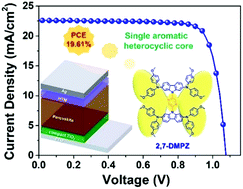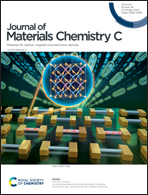Hole transport materials based on a twisted molecular structure with a single aromatic heterocyclic core to boost the performance of conventional perovskite solar cells†
Abstract
Hole-transport materials (HTMs) have a critical effect on the performance of perovskite solar cells (PSCs). So far, 2,2′,7,7′-tetrakis[N,N-di(4-methoxyphenyl)amino]-9,9′-spirobifluorene (spiro-OMeTAD) is commonly used as an HTM for highly efficient PSCs. The HTMs with a spiro framework like spiro-OMeTAD usually show high thermal stability and good film forming capacity. To date, massive efforts have been made to prepare new HTMs with a spiro core structure connecting two electron-donating moieties. However, the harsh synthetic routes and purification processes of the spiro structure are the main challenges for their large-scale applications. To solve this issue, herein, a single aromatic heterocycle pyrazine is used to connect two electron-donating groups for the construction of new HTMs (denoted as 3,6-DMPZ and 2,7-DMPZ), which could be synthesized under mild reaction conditions with high yield (over 60%). Moreover, in terms of molecular structure, the electron-withdrawing property of the pyrazine group could increase the molecular polarity, enhance intermolecular interactions, and thereby promote charge transfer, affording a high hole mobility. Experiments indicate that 2,7-DMPZ film shows a more uniform morphology, better hole transport property, and more efficient charge transfer compared to the 3,6-DMPZ film, endowing the 2,7-DMPZ-based device with an impressive power conversion efficiency of 19.61% with enhanced stability.



 Please wait while we load your content...
Please wait while we load your content...